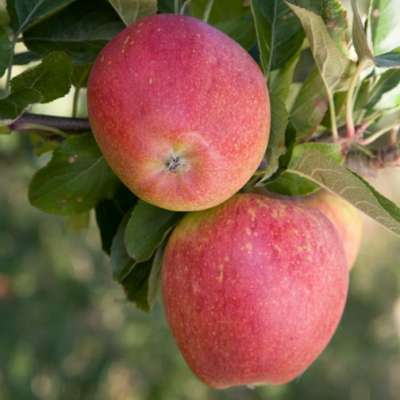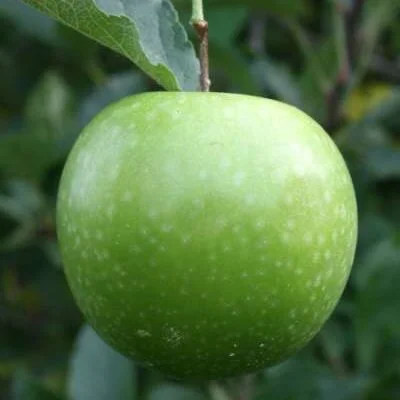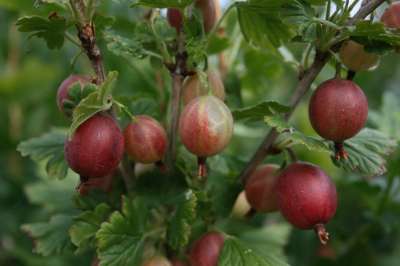Your basket is currently empty!
‘Plant Pears for your heirs’ This old saying used to be very true, but not anymore. By using the right technique it is quite normal for a three year old tree to be bearing many fruits and ready for regular cropping.
The ensure these fruits early in life the first essential is to choose a rootstock for a dwarfing effect. Like all tree fruits, pears are grafted onto a rootstock that controls the height that the tree will eventually grow to.
Pears used to be grafted on to the old wild Pear stock that made very large trees, often towering over neighbouring buildings and into the sky! These magnificent old trees often had a lifespan of 60 – 200 years and it was often 20 years before you picked your first fruit. Not really suited to todays smaller gardens!
The modern rootstocks are Quince C and Quince A, and lately, the Pyrodwarf stock. Either of these is suitable as Quince C and Pyrodwarf only grow to around 8′ and Quince A around 16′, depending on the variety you choose. When growing for early fruits this choice of variety is important as the more compact a tree is, the more likely it is to fruit early in life. Always remember that what you are aiming for is more fruit and less wood – while a tree is making long vigorous growth it is not going to produce much fruit.
Trained trees always tend to fruit earlier than an ordinary bush or half standard tree. By a trained tree we mean any tree that is grown in arestricted form, not just a Fan or Easplier, but cordons, columns, restricted dwarf bush and stepover.
Pears are naturally slower than Apples in coming into crop and it is essential to remember that hard pruning delays cropping even further. Never hard prune a young Pear tree unless you are aiming to produce a large tree. The earliest crops with bush trees are produced by just light tipping of the leaders and leaving as many of these leaders as possible. Just prune about 2″ off the tips of the branches and that is all.
When the tree has reached the height that you require do not be tempted to just cut off the excess growth. If you prune 1′ off the growth this winter, by next Autumn this will have been replaced by 2-3′ of growth!
You are better to tie the taller branches down. This system is known as festooning and is very simple and effective. The end result makes a very attractive tree. All that you have to do is tie a piece of string to the top 2″ of the rbanch you wish to lower. Gently pull the branch down until the top of the branch is pointing straight towards the ground and then tie the string to the lower area of the tree trunk to hold the branch in that position. Any type of soft string is suitable and there is no limit to the number of branches you can tie down.
After one growing season the string is removed as the branch will remain in that position naturally. This bending over of the branches not only reduces the height of the tree it induces fruit production giving earlier and heavier crops.
With trained trees you should always prune in Summer as this summer pruning further restricts the growth of the tree, which in turn means more fruit buds earlier in life. As soon as the new side growths are about 9″ long prune them back to about 4-6″, cutting just above a bud. The system is basically the same for all types of trained trees whether they are growing as upright columns, horizontal branches like an espalier, or at an angle as with a fan. Just treat each branch as if it were an individual cordon.
When the branch of an espalier or fan has reached the length you require you can keep cutting them aback if you wish, but it is far better to loop the end of the branch round on itself in a smooth curve and tie it in. This mini festoonstops the branch growing any longer and again increases fruit buds.
By remembering the few basic principles of choosing a dwarfing rootstock, a compact growing variety and pruning lightly, your trees will be fruiting very early in life and soon your trees will be fruiting so well that you will probably need to reduce the fruiting spurs! This is very simple to do as the fruiting spurs on a Pear are very easy to identify. All you have to do is prune back by about one third or rub about half the buds from the spurs leaving or two per spur.
It is a pity that Pears suffered such a bad reputation for so many years for being so difficult. They are as easy to grow as an Apple or a Plum and with todays modern rootstocks no longer do we plant ‘Pears for your heirs’!
Tips for the beginner
Ensure you plant a tree that has been grafted onto a dwarfing rootstock.Look for the word EMLA as this indicates that the tree is free of virus.
Select a variety that naturally grows compact.
Always prune lightly, hard pruning encourages woody growth at the expense of fruit.
Consider planting a trained tree – columns and cordons are especially easy.
Compact Growing varieties
Concorde, Dr Jules Guyot, Conference, Emile d’heyst, Packhams Triumph, Winter Nellis.






